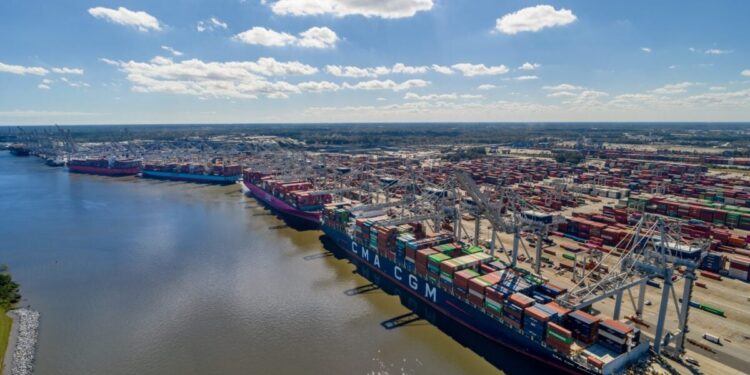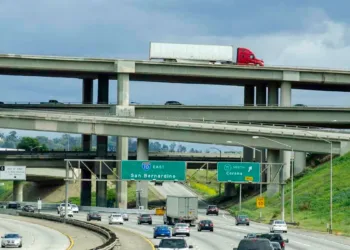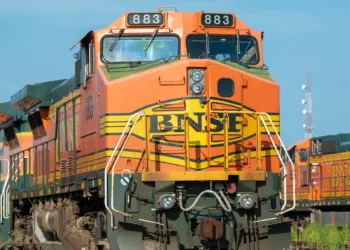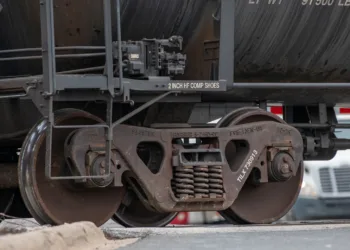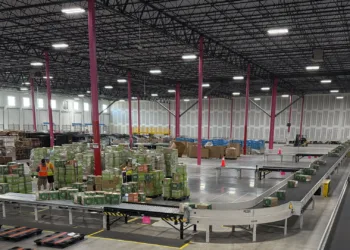“The sweetest words are, ‘Here is your end’ (of the bargain),” so a time-honored saying goes.
That’s never more true than in union negotiations where just about every player has a piece of the action, and particularly in the current bargaining between port employers and union dockworkers at three dozen ports on the U.S. East and Gulf coasts, a public-private kerfuffle that’s already gone all the way to the White House.
Unlike contract talks between, say, baseball team owners and the players union, which take place under a glare of 24-hour media, bargaining on longshore contracts is notoriously confidential, shrouded in secrecy save for occasional dueling news releases that only succeed in flattening the actual drama that threatens to hold hostage a good chunk of a U.S. (and global) goods economy that’s bigger in value than all the professional sports leagues put together. The rare leak of actual contract details is promptly disavowed as stakeholders wait anxiously for the next announcement.
That’s about how it’s gone during the current round of bargaining between port employers represented by the United States Maritime Alliance and the International Longshoremen’s Association, which count 25,000 workers in container and ro-ro services at ports from Maine to Texas. Whatever talks were taking place came to an abrupt halt in June when the union refused to buy what the employers were selling. The ILA, led by President Harold Daggett and his son, Executive Vice President Dennis Daggett, has since refused to return to negotiations, ratcheting up the rhetoric by calling for “war” against employers and insisting that “the docks belong to us.”
Now, it’s traditional for unions to “get paid” when times are good, and most indicators are on an upward trend. GDP grew at an annual rate of 3% in the third quarter of this year, up from 1.6% the previous two quarters while lower energy, food and transportation costs helped inflation cool to 2.5% in August, the smallest one-year increase since pandemic-influenced March 2021.
Throw in a tight jobs market, and that’s why a number of high-profile companies from UPS to railroads, airlines and automakers settled with their unions. Yes, machinists are on strike at beleaguered Boeing and thousands of hotel workers have walked off the job seeking higher wages and better working conditions, but mostly there is labor peace.
Containerized imports through U.S. gateways continue to surge to near-record levels, an indication that however people feel about the price of eggs, consumer sentiment to buy stuff remains resilient, a good sign leading up to the retail holiday season. Which brings us back to the East Coast longshore labor dispute.
As everyone discovered during the COVID-19 pandemic, container ports are a choke point in a supply chain as essential to daily life in the United States as water, electricity and telecommunications. Disruptions have a ripple effect throughout the economy and are exponentially compounded as goods pile up at ports, terminals, warehouses and other distribution points. So it takes longer to restart the flow of goods than it does to stop it. Considerably longer.
The domestic intermodal supply chain begins at the nation’s ports, and with some exceptions, it’s union employees who see to the efficient handling of incoming containers through these ports. Here’s where we see the players sitting in on a game where there’s more than one winning hand and a pot that only grows larger. But union contract negotiations aren’t like a winner-takes-all game of Texas Hold ’em. The optimal outcome of any negotiation is that all sides are rewarded as part of a compromise outcome.
But wait, it’s an election year. That’s like a doubling down for each container move! President Joe Biden courted union support in his abortive reelection campaign, going so far as to walk with auto plant employees on their picket line. The United Auto Workers, flush with new contracts, rewarded Biden with its endorsement (since inherited by Vice President Kamala Harris, the Democratic nominee since Biden dropped out in June).
So it was probably with more than a little trepidation that a cabal of importers, manufacturers, trade groups and House Republicans tried to pressure Biden to block an Oct. 1 strike by the ILA, for the good of the country, they said.
There’s a remedy for just such a move. The Taft-Hartley Act gives the president powers to intervene in a labor dispute if it might compromise the country’s essential services, and orders a cooling-off period while the sides resume contract negotiations under federal facilitation. Taft-Hartley was last invoked in 2002 by President George W. Bush to resolve a West Coast dock strike that threatened to imperil his first-term agenda.
So how to thread the needle? Biden told businesses he would not block a strike, but he might be playing semantics and still come back later and intervene, like Bush. Or, Biden can give the union some rope and let the work stoppage drag on just long enough to bake in 65,000 union votes ahead of an election where swing state polling is razor-thin, get employers to cave on a new longshore contract and — ta-da! — save Christmas!
That’s the view from on high. But there are other state and federal bodies waiting for their turns.
A container comes in from abroad, right away U.S. Customs and Border Protection claims its share of duties, taxes and tariffs. Ports are mostly public entities and extensions of local governments that rent space to private terminal operators, so the port is going to take its cut in order to continue to operate, and the local and state governments are going to collect taxes on goods as well as on port employees’ paychecks.
The past 20 years have seen an infrastructure arms race as port authorities of all sizes vie to outspend one another in a breathtaking bid to expand their container handling capacity while ocean carriers build ever-larger ships. And if a port can pave another hundred acres to expand ro-ro, well, vehicles are lucrative sources of import duties — up to 25% for a truck based on value.
So it’s always been in the interest of public entities not only to have thousands of union members on the ground, but to have that number actually increase, if at all possible. And while we’re at it, don’t forget the thousands more truck drivers who provide drayage services hauling containers in and out of the ports. The states and federal government collect taxes on their wages, too.
But a union isn’t a union without dues-paying members, so preserving jobs by keeping automation technology out of U.S. ports is always a high priority for ILA leadership even as, observers say, it compromises the efficiency of operations. Ports in Asia and Europe deploy advanced automation to make operations as efficient as possible, and U.S. ports struggle to keep pace. In 2023 the Port of Los Angeles-Long Beach complex, largest in the U.S., only ranked ninth for volume among the world’s container ports, and New York-New Jersey didn’t crack the top 20.
But who cares?!
The U.S. is the largest market for everything from cellphones to furniture to model trains made in China, the world’s largest exporter. China rightly has to worry about moving its stuff out as quickly as possible. While some automation has found its way into U.S. ports — always under the auspices of union contracts — governments and ports and, yes, unions are caught in the aforementioned Möbius strip of wants and needs that isn’t likely to substantially change the structure of U.S. port operations in the near term. And it doesn’t matter if getting containers through those ports is like trying to push an elephant through a keyhole. Let us worry about that!
Or more accurately, let consumers worry about it. They’re the ones buying all that imported merchandise, and they’ll be the ones paying for disruptions, delays and other assorted supply-chain snarls that will be baked into the price of whatever shiny object hits store shelves.
Eventually, the ILA will get its contract, containers will flow again and there will be labor peace — for six years at least.
Find more articles by Stuart Chirls here.
Related coverage:
Port employers seek NLRB injunction against longshore union
Where ILA strike might go from here
Longshoremen port strike unlikely to hinder holiday retail season, expert says
The post Analysis: Port poker and the East Coast dock strike appeared first on FreightWaves.



